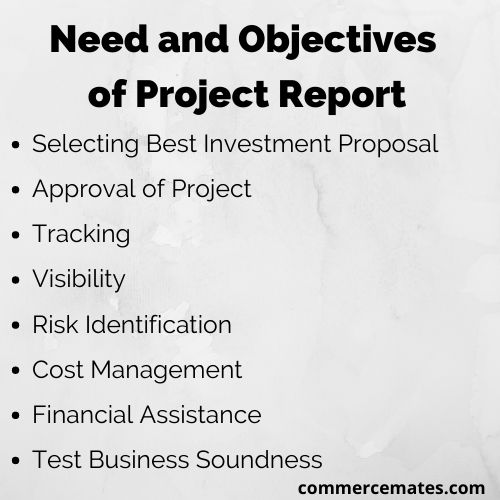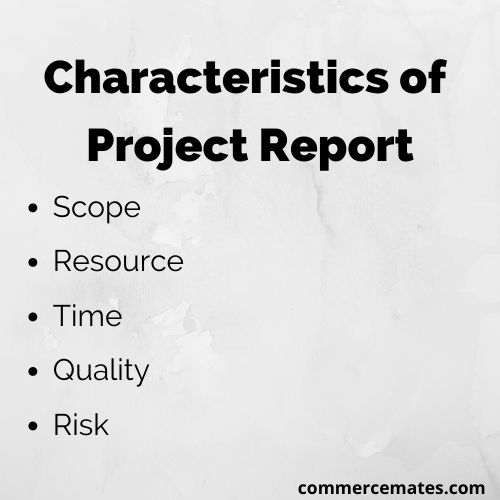Contents
Meaning of Project Report
what is project report?
The project report is a document that contains all information regarding the proposed project. It is served as a blueprint of all operations to be undertaken for attaining the desired results. The project report is basically the business plan of action and clearly describes its goals and objectives. It is one that helps in converting the business idea into a productive venture without any chaos or confusion as it defines strategies for project execution.
Information from various aspects like technical, financial, economic, production and managerial are together constituted in project report for better understanding. It describes all inputs required for the accomplishment of a project so that they can be arranged accordingly at the right time.
The project report is an essential tool available with management for proper monitoring of operations and helps them in recognizing any problems. Managers through project reports are able to estimate all costs of operations and possible profitability of the proposed project.
Contents of a Project Report
Following are the contents of a project report.
Title
The title page of the report denotes the title of a project and the author’s name. It mentions the name and detail of industry for which the project is undertaken. This page must clearly define the area and scope of project.
Abstract
Abstract is a brief summary giving details about the contents of a project report. It provides an idea to reader regarding what is project report about. Anyone who does not know anything about report simply by reading its abstract can make out whether it is of their interest or not. Abstract is generally half a page long.
Acknowledgements
This section of report denotes the individuals who assisted you during your project work. It is meant for thanking the people who provided you technical or any other type of assistance such as your supervisor.
Contents page
Content page tells about the main chapter and sub sections included in the report. Chapters with proper titles are mentioned along with the page numbers telling where the particular chapter/section begins and ends. It should be ensured that only sufficient levels of subheadings are provided under each chapter.
Introduction
It is the most crucial element of the project report. The introduction tells about the nature and scope of the report to the reader. This part summarizes what the author set out to attain, gives a clear description regarding the background of the project, main contributions, and relevance. The introduction shall summarize the key things in the report and provide the sections containing the technical material.
Background
Background component sets the project report into context and describes the layout for attaining project goals. For meeting out the proposed goals different approaches should be evaluated for choosing the efficient one. However, this part of report can be included as a part of introduction also but it is ideal to present it as a separate chapter in case if project involve extensive amount of research and ground work. All pieces of work which are listed should be provided with proper sources from where they are referred.
Body of report
This is the central part of project report which contains three to four chapters which describes all technical work undertaken for the completion of project. The chapter’s structure dependent upon project which reflects the development of project in chronological order. It should be justified why a particular approach is chosen above other alternatives mentioned in background component. Every interesting features and problems during the implementation should be properly documented. All contents relating to testing and integration should be thoroughly discussed with the supervisor.
Conclusions and future work
It denotes the achievements made as a result of completing the project. This part of report concludes the success and failures of a project. It also provides suggestions for future work of project for taking it further. No project is completely perfect and each of it come with certain limitations.
Bibliography
Bibliography tells about the books, articles, journals, manuals etc. which are used while doing the project or referred in the report. Full and accurate information regarding sources used such as title, author name, issue and page number should be mentioned for readers. Providing the source of information helps readers in validating the facts of report.
Appendix
This part comprises of information that is peripheral to main body of report. Things included here are such as program listings, graphs, proofs, tables or any
other thing that would break up the theme of text if it appeared in situ. All material should be bind in a single volume and compressed as much as possible.
User Guide
This section consists of proper instructions for better understandability of users. Suppose a project that had led to the development of new software, it should provide a complete guide on how to use it. It displays all essential features of project using diagrams for illustrating them properly. User guide component of report should be kept simple and concise.
Need and Objectives of Project Report

- Selecting Best Investment Proposal: Project report is an efficient tool for analyzing the status of any investment proposal. It shows the expected profitability and risk associated with the project and this way helps in choosing the best option.
- Approval of Project: It is essential for registration or approval purposes of the proposed project. Different authorities like District industries center, Directorate of industries, government departments, etc. require project reports for giving approval.
- Tracking: The Project report assists in tracking the current activities of the project. It helps team members and other stakeholders to check the project progress from time to time and helps in finding out any deviations against the original plan.
- Visibility: Another important advantage of having the project report is that it gives full insight into the project. It gives a clear description of activities to be undertaken and avoids any confusion or disorder.
- Risk Identification: Identification of risk is a significant step for the completion of every project. The project report enables in spotting the risk early and taking all corrective actions timely.
- Cost Management: Project report helps in managing the expenses through regular reporting of all activities. It sets the standard cost of every operation in advance and helps in finding out any deviation in these costs through tracking of the project.
- Financial Assistance: It is an important tool for availing financial assistance from financial institutions or fund providers. The project report enables financial institutions in judging the profitability of the proposed project and then takes the decision accordingly for approving the funds.
- Test Business Soundness: Project report helps in testing the profitability and soundness of the proposed project. It tells the total estimated costs, possible income and risk associated with any proposal.
Characteristics of Project Report

- Scope: The project report gives a clear picture of what is to be done or to be achieved. It describes the goals of the proposed project and activities to be undertaken for achieving these goals.
- Resource: It shows the means or resources required to meet the desired scope. Project report serves as the roadmap which tells the direction in which business should go for attaining its goals.
- Time: The project report denotes the standard time required for the completion of each and every task of the proposed project.
- Quality: The project report explains the desired standards to be achieved by the completion of all tasks. Limit of deviations that can be accepted from these defined standards are also contained in this report.
- Risk: Risk is an unavoidable factor associated with every business and needs to monitored properly. The project report considers all risk factors that may arrive at the completion of the proposed project and also tells the ways for recovering from these factors.